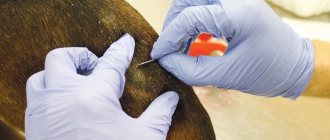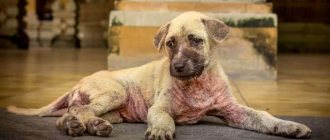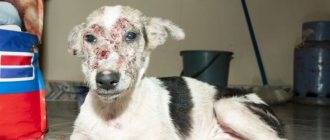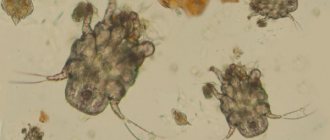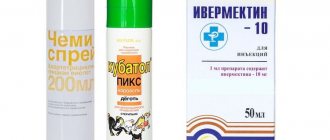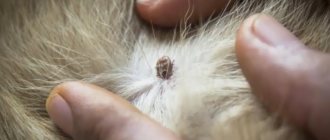What is demodicosis in dogs?
Biologists have discovered more than a hundred species of Demodex; only three parasitize dogs:
- Demodex canis;
- Demodex cornei;
- Demodex injai.
Hundreds of studies have been published on these parasites, but questions still remain. In many publications, the demodex mite is described as a permanent inhabitant of the skin of all dogs, which multiplies when the immune system fails. This information is contradicted by a study of scrapings from healthy dogs without external signs of demodicosis. Of the 415 animals, only 36 were found to have ticks. The results of the study are described in a textbook on veterinary medicine.
A subcutaneous mite cannot be seen without a microscope; its body length does not exceed 0.26 mm. Once on the skin, the parasite penetrates into the cavity of the hair follicle, sebaceous glands and excretory ducts. As it moves, it gnaws out paths in the epithelium, destroying the cells of the follicle, epidermis, and hair roots.
The life cycle of demodex lasts 25–30 days. During this time, the female lays dozens of eggs in the hair follicles. As the colony of parasites multiplies, it grows and conquers new living space. And the animal develops a demodectic focus.
Any dog can get demodicosis, regardless of gender, age and breed. But according to observations, the subcutaneous mite more often attacks short-haired animals:
- French, English, American bulldogs;
- Rottweilers;
- boxers;
- Dobermans;
- bull terriers;
- dachshund;
- German Shepherds and Great Danes;
- Staffordshire Terriers;
- Shar Pei.
Short hair does not protect well from external irritants, so dogs actively secrete sebum - a breeding ground for parasites.
What does a subcutaneous tick look like in dogs?
You can see what the parasite looks like in the photo of a subcutaneous tick. Demodex visually resembles a small cigar, the size of which does not exceed 0.4 mm. You can see it only with the help of optical devices and in close-up photographs.
Is canine demodicosis contagious to humans and other dogs?
People also suffer from demodicosis, but other species live on them: Demodex brevis and Demodex folliculorum. A dog tick can land on human skin, but will not be able to feed or reproduce and quickly dies in an alien environment.
With close, prolonged contact, adult ticks move from one dog to another. However, the likelihood of developing the disease depends on the state of the immune system. The risk group includes:
- weakened dogs;
- sick and recovering;
- elderly over 10 years old;
- puppies up to one year;
- animals with skin lesions.
A healthy dog with a normal immune system will not get demodicosis even after close contact with a sick animal.
Dog ticks are not dangerous for cats. They are parasitized by other species of Demodex - Demodex gatoi, Demodex cati.
What contributes to the manifestation of demodicosis
As a result of veterinary studies, it was found that Demodex Canis is part of the normal skin fauna of tetrapods. Therefore, when taking a skin scraping, it is often found in completely healthy animals.
A tick can live on a dog’s skin all its life without causing illness or causing any inconvenience to its “carrier.” But, as a result of some external or immune changes, the parasite can wake up from hibernation. Its numbers increase sharply, which leads to a condition called demodicosis.
The following factors can contribute to the manifestation of demodicosis as a disease:
- Age. The disease usually affects young dogs under one year old and older pets over 10 years old. The reason for this is the immature immunity of young animals or the weakened immunity of older dogs due to age.
- Heredity. Often the disease can be inherited from the mother to puppies.
- Seasonality. Most often, demodicosis occurs in dogs between April and September. This is due to warm weather, which is favorable for the growth of Demodex Canis. During this period, the development cycle of the parasite is halved. Instead of 3-4 weeks, the tick turns into an adult in 2 weeks. During the warm summer period, the female manages to lay thousands of eggs, which complicates the treatment of the disease.
- Stress. Constant tension caused by one reason or another primarily has a negative impact on the psychological state of the animal and its health. All internal systems of the body are under attack: the gastrointestinal tract, cardiovascular and endocrine systems. A weakened body can no longer resist the influence of external factors. As a result, the slightest contact with an infection or virus immediately leads to the development of a serious illness.
- Poor nutrition. If dogs are fed improperly, the functioning of the gastrointestinal tract and liver is disrupted. This leads to the development of skin diseases such as psoriasis, dermatosis and so on. Alopecia (hair loss) appears on the skin, which is easily “settled” by fungi and mites. In addition, poor nutrition leads to malfunction of internal organs, which weakens the body and reduces immunity.
- Weak immunity. This is the main reason for the development of demodicosis. And, one might say, a collective factor. All of the reasons described above contribute to weakening of the immune system: housing, improper feeding, stress, tumors, prolonged exposure to medications, helminths, lack of proper care, contact with sick animals and much more.
- Lack of proper care. The likelihood of infection with demodicosis is high in the absence of normal animal care: poor hygiene, poor nutrition, untimely deworming and vaccination, self-walking and communication with stray dogs.
- Contact with a sick animal. If your pet's immunity is weakened, then any contact with a sick animal will most likely lead to infection.
Forms of demodicosis in dogs
Based on the area of damage, there are 2 forms:
- Localized – up to 4 demodectic lesions up to 2.5 cm in size.
- Generalized – 5 or more scattered affected areas or extensive skin damage. This form occurs as a continuation of an untreated focal form or develops independently.
The division is conditional, since the ratio of the size of the dog and the affected areas is taken into account. For example, 3 lesions with a diameter of 2 cm for a Chihuahua are already generalized demodicosis, and 5 affected areas of 3 cm for a mastiff are a localized form of the disease.
Separately, pododemodecosis and otodemodecosis are distinguished. In the first case, lesions form on the paws and fingers. In the second, the parasite infects the surface of the ear.
Forms of the disease
The first signs of the disease become noticeable when the demodex mite in dogs, against the background of active reproduction, creates large populations. Pathology can occur in different ways, so there are several forms:
- focal (local);
- pustular;
- generalized.
Juvenile demodicosis in dogs is diagnosed when the animal is not yet 1 year old.
Focal
The mildest form of pathology is considered to be focal or scaly demodicosis. In sick dogs, 3 to 5 small flaky areas of skin without hair are visualized, having a chaotic location. Affected lesions are found on the head, chest, abdomen or limbs. Under favorable circumstances, the disease goes away on its own after 4-16 weeks.
However, some veterinarians still insist that even with this form, pathologists are better off treating with topical drugs. This will help avoid relapse and also reduce the risk of developing a more severe form of the disease. Some parasites begin to multiply actively when the animal experiences hormonal fluctuations, is stressed, or has recently been vaccinated.
With local demodicosis and the absence of other diseases, 8 out of 10 pets are cured on their own. But relapses of the disease cannot be ruled out.
Pustular
Skin mites often provoke the pustular form of the disease. It is a complication of the scaly form or develops independently.
Dense nodules of damaged lesions change and red-brown or black pustules appear in their place. A month after the onset of the disease, the pustules lose their integrity. And the purulent contents coming out of them have blood inclusions.
During laboratory tests, large colonies of acne glands are found in such secretions at various stages of their development. The wounds emit an unpleasant odor. When the pustular discharge dries, the wound becomes covered with a scab. It is a crust formed by coagulated blood, pus and dead tissue.
Generalized
Generalized demodicosis is the most severe form of acariasis. With it, the same symptoms are observed as with focal or pustular. The difference is that larger areas of the skin are affected.
Generalized demodicosis is diagnosed if more than 5 foci of alopecia are found on the animal’s body.
With this form of the disease, the tick gradually invades new territories. His next target is the internal organs. The immune system, hepatobiliary region and digestive tract are greatly affected by the active activity of parasites. The pet stops eating. He often experiences vomiting, convulsions, and spatial disorientation. Over time, due to general exhaustion, the animal dies.
There is also a separate type of the disease - generalized juvenile demodicosis in dogs. This is a childhood pathology that develops in puppies. The disease is hereditary (autosomal recessive gene). Juvenile demodicosis in a puppy is transmitted from the mother.
This pathology develops against the background of the fact that the production of oxytocin increases in a nursing female immediately after the birth of her offspring. Ticks quickly pass from the sick bitch to the offspring, provoking the onset of the initial stage of the disease.
Juvenile demodicosis in dogs under 1.5 years of age
Demodex mites are transmitted to puppies from their mother within 2–3 days after birth. Most kitties become asymptomatic carriers; the parasites do not affect health in any way. If the fragile immune system cannot cope and does not restrain the proliferation of parasites, by 3 months or later the puppy will develop demodicosis.
An additional burden in the 1st year of life is vaccinations, changing teeth, and cupping. These events can trigger stress, a dangerous enemy of the immune system. Focal juvenile demodicosis in 90% of cases goes away as the puppy grows up and develops immunity.
For the development of the generalized juvenile form, genetic prerequisites are needed. The reproduction of mites is inhibited by the T-link of the immune system, which recognizes and removes foreign agents. Dogs with defects in protective T cells are themselves prone to generalized demodicosis and pass this defect on to their offspring.
Symptoms of the disease
Demodicosis develops gradually. At least 4 days pass from the onset of the disease to the appearance of visible mite-affected areas of the epidermis. Depending on the type of disease, the following symptoms of demodicosis in dogs are distinguished:
- The scaly form is manifested by the appearance of dry scales that resemble fish scales or dried mud. The scales glue the fur together, and after a while they fall off along with it. In bald areas, pus is visible.
- The pustular form is accompanied by the formation of vesicles with purulent contents at the base of the fur.
- The generalized form combines the symptoms of the first two types of the disease.
In general, demodicosis has the following manifestations:
- constant severe itching - the animal can itch for several hours in a row;
- redness at the base of the fur or the appearance of scales;
- after a few days, small blisters with liquid inside appear at the site of inflammation, which first has a brick and then a clayey tint;
- on the fourth day of the disease, hair falls out, bubbles with liquid burst, releasing unpleasant-smelling contents.
The general condition of the dog is characterized by lethargy, loss of appetite, body temperature can drop to 37 degrees.
Causes of demodicosis in adult dogs
In animals older than 18 months, demodex mites more often “wake up” against the background of other disorders that reduce the overall immunity and barrier functions of the skin:
- bacterial, allergic dermatitis;
- hormonal imbalance;
- infection with worms;
- oncological diseases;
- autoimmune pathologies.
Dogs with impaired hair growth and decreased skin tone are predisposed to the development of demodicosis. It is easier for a subcutaneous mite to penetrate into the cavity of the follicle when the hair grows slowly after molting or the root does not adhere tightly to the walls of the hair follicle.
Often demodicosis begins when the hormonal balance changes. This happens during pregnancy, after estrus or long-term treatment with corticosteroid drugs. Medicines save from severe inflammation, but lead to the death of lymphocytes and suppress the immune system. During the treatment of demodicosis, corticosteroids are completely excluded.
Unbalanced nutrition, lack or excess of macro and micronutrients affects the condition of the skin and disrupts protective functions. The dog's hair falls out, bald areas appear, skin tone decreases, and dermatitis develops. As a result, favorable conditions are created for the spread of ticks.
Close-up photo
Localized (focal)
It is considered the mildest form, also called “scaly” demodicosis. Most often, it manifests itself in immune deficiency during pregnancy, after childbirth, or through direct contact with an infected person. It occurs as reddening of the skin on the neck, abdomen, around the eyes and behind the ears. Foci of inflammation are few (3-5).
The animal itches, becomes irritated and nervous. In place of redness, scales of keratinized skin appear. The epidermis may thicken and crack. Acne rashes are often visible.
The disease has 2 development paths:
- The animal recovers on its own within 1-3 months (often, veterinarians do not even prescribe special medications), this option occurs in 85-90% of cases;
- The localized form will turn into a complicated generalized form, in which case it will not be possible to do without treatment.
In the photo Localized (focal) demodicosis
Generalized
This form of the disease can be a severe stage of development of the scaly type. The disease progresses to the stage of the tick spreading throughout the body. First of all, the skin suffers, and other foci of inflammation appear. Gradually, the entire epidermis becomes covered with scabs and swells. The animal emits a terrible odor due to the rotting process. Without treatment, the pet goes completely bald in 1-3 months .
The disease can disappear on its own if the immune cells begin to work effectively in time. The most positive forecasts for pets under 4 years old . The older the dog, the more difficult it is to cure demodicosis (except for cases of infection in puppies).
The danger of this form lies in the fact that the tick, which has not found food in the epidermis, gnaws its way to the organs. Therefore, generalized demodicosis can lead to problems with digestion, cardiac and circulatory systems, and lungs. The pet will suffer from vomiting, diarrhea, seizures, and general malaise. This condition may appear within 5-10 months if treatment is refused.
In the photo Generalized demodicosis
Juvenile
This is a subspecies of the generalized type. It differs in that it is diagnosed in puppies up to one year old. It is transmitted from a sick mother to offspring. Doesn't cause any particular inconvenience. The main symptom is baldness around the eyes and redness of the skin. Such demodicosis is treated only after the puppy gets stronger. Often, the immune system copes with the tick on its own.
The photo shows juvenile demodicosis
Pustular
A subtype of demodicosis that occurs both independently and as a result of an untreated scaly type. A distinctive feature is that nodules form in bald areas, turning into pustules filled with pus. These appear as reddish or brown blisters. After 3-4 weeks they burst, the secreted liquid dries and forms scabs. During this process, the dog emits a terrible odor.
Treatment of such a disease requires not only stimulation of the immune system, but also disinfection of the destroyed epidermis. With the pustular type, the dog is defenseless against surrounding fungi, viruses and harmful bacteria.
Without proper treatment, pustular demodicosis not only develops into generalized demodicosis, but also entails other infectious diseases; cases of blood poisoning have been recorded.
Pictured is pustular demodicosis
Otodemodecosis and podomodecosis
Varieties of focal localized demodicosis may be part of generalized one.
- Otodemodecosis is inflammation inside the ear. The pet is bothered by severe itching around and inside the ear, black crusts appear, and hair falls out in the ear canal.
- Pododesodecosis is an inflammation of the epidermis on the paws. Symptoms do not change; cellulite and venous suppuration often appear. Spaniels are prone to the disease. Most often, the disease spreads to all 4 limbs.
Otodemodecosis in dogs
Symptoms of demodicosis in dogs
The initial stage proceeds unnoticed. The fur is thinning in places. Skin color does not change. There is little or no itching. Well-being and behavior remain the same. As the tick spreads, the disease takes on a scaly (squamous), pustular or mixed clinical form.
At an early stage, a demodectic lesion seems harmless.
Signs of scaly demodicosis
The development of this form is indicated by the following symptoms:
- The dog develops round bald areas with clear boundaries with a diameter of 1 to 20 mm. More often they appear on the face, around the eyes, on the forehead, and limbs.
The initial stage of scaly demodicosis.
- The skin on hairless areas turns slightly red, flakes, and becomes covered with scales.
- The fur at the border of the demodicosis lesion does not stay in the follicles and falls out.
- Gradually, the skin becomes rougher, cracks, and dense nodules appear on it.
- At a later stage, the color changes to bluish-gray with red inclusions.
In the scaly form, the animal does not suffer from itching. It begins when a secondary bacterial or fungal infection occurs. Body temperature often drops to 37℃.
Symptoms of pustular demodicosis
This form develops if pathogenic or conditionally pathogenic bacteria multiply in the demodicosis lesion:
- The skin turns red, swells, and becomes covered with nodules.
- Gradually they turn into yellow, brown, black bubbles with liquid.
- When the pustules open, pus flows out, sometimes with traces of blood. After drying, crusts form.
- The skin thickens, wrinkles, becomes cracked, and smells bad. Ulcers form at the site of burst pustules.
With otodemodecosis, the ears become swollen, hot, and painful. The inner surface turns red, sulfur is released intensely, and itching occurs. Demodicosis of the paws is painful. While walking, the dog rubs the injured skin. In addition to the standard symptoms, lameness occurs.
Forms and symptoms of demodicosis
The first signs of the disease are visible only when the parasite is actively reproducing and has already formed entire colonies.
Depending on the course of the disease, there are three main forms of the disease. Let's start, so to speak, with the mildest degree of severity and work our way up.
Scaly (focal) form of demodicosis
The focal form is considered the mildest. The animal begins to itch intensely. On the skin around the eyes, nose, ears and neck area, redness and rounded hairless areas of skin appear, covered with small pityriasis-like scales of keratinized epidermis.
The skin in these areas is red and rough, sometimes with cracks and small nodules. The hair along the edges of such areas is sparse and very brittle.
At this stage, there are not many outbreaks: from three to five. Typically, bald areas of skin are located on the head, paws or chest.
The focal stage lasts 1-2 weeks. Next comes the pustular stage of manifestation of the disease.
Pustular demodicosis
Pustular demodicosis can develop as a complication of the scaly form, or independently. Dense nodules on the affected areas transform into red-brown and sometimes black pustules.
At 4-5 weeks from the onset of the disease, the pustules burst and pus is released from them, often mixed with blood. During laboratory examination, entire colonies of Demodex Canis can be found in such secretions at different stages of their development.
An unpleasant odor emanates from the affected areas. When the pustular mucus begins to dry out, a scab (a crust formed by blood, pus and dead pieces of epidermis) forms on the surface of the wound.
In the absence of proper treatment, the disease develops into the most complex - generalized form.
Generalized form
Generalized demodicosis in dogs is the most severe stage of the development of the disease. It is characterized by the same symptoms as in the first two cases. But, skin lesions become more extensive. If 5 or more bald spots appear on the animal’s body, experts diagnose the generalized form of demodicosis.
The boundaries of disease-affected areas are constantly increasing and “spreading.” The dog becomes like a sick dinosaur with inflamed areas of skin covered with scabs. A heavy fetid odor emanates from the four-legged creature. Without proper treatment, after 2-3 months, the animal becomes completely bald.
Having “eaten” the skin, Demodex Canis gradually moves further and affects the internal organs. The pet refuses to eat. Vomiting, convulsions, general weakness and loss of coordination appear. Exhaustion sets in and the animal dies.
There is a type of generalized form - this is generalized juvenile (children's) demodicosis. This form of the disease is considered hereditary and is transmitted from mother to puppies through a special autosomal recessive gene. Most often, puppies under one year of age are affected. Treating this form of the disease is very difficult and takes a long time. After recovery, such pets are sterilized.
Analysis for demodicosis in dogs
It is impossible to make an accurate diagnosis based on external signs. Symptoms of demodicosis are similar to clinical signs of other diseases:
- Bacterial skin infections - folliculitis, pyoderma, impetigo, furunculosis.
- Fungal infections - trichophytosis, microsporia.
- Allergic diseases – flea infestation, atopic dermatitis, food sensitivity.
- Infection with scabies mites - sarcoptic mange.
- Thyroid dysfunction and hormonal imbalance – hypothyroidism.
The final diagnosis is made after microscopic analysis. The doctor makes a deep scraping from the lesion with a scalpel until a drop of blood appears. Then he transfers the materials onto glass smeared with Vaseline. Sexually mature individuals, larvae, and eggs are easily visible under a microscope. After counting the parasites at different stages, an acarogram is displayed.
Demodex mites under a microscope
If single adult individuals are found, then up to 5 repeated scrapings are made from the affected and healthy areas. In sensitive areas, such as around the eyes, instead of skin, a hair pluck is taken for analysis.
Additional studies will be needed to identify concomitant disorders:
- clinical urine test,
- blood biochemistry;
- coprogram;
- hormonal analysis of blood serum;
- bacterial culture to determine the sensitivity of the microflora if antibiotics are prescribed.
During treatment, scrapings are repeated every 3 to 4 weeks until not a single tick is found in at least two samples at a monthly interval.
Diagnostics
It is quite easy to identify demodicosis in dogs. Clinical symptoms are quite characteristic of this particular disease.
In addition to the characteristic external signs, for an accurate diagnosis, an additional deep scraping is taken from the affected areas of the skin. In order for more ticks to come out, the skin is squeezed and scraped so deeply that droplets of blood appear. In the complicated form of demodicosis, mites are found in entire colonies: with eggs and larvae.
Demodex Canis under a microscope
If demodicosis is at the initial stage, and the clinical picture is quite typical for this disease, and no mites are found in the material taken by scraping, the scraping is repeated in another affected area.
In addition, to make a correct diagnosis, a study of heredity is carried out. If these are very small puppies, then the analysis is also taken from the mother dog.
Treatment of focal and generalized demodicosis in dogs
There is no general treatment regimen for all dogs. When choosing drugs, a lot of details are taken into account: age, heredity, area and shape of the lesion, test results, severity of symptoms, concomitant diseases.
According to the observations of veterinarians, focal uncomplicated demodicosis resolves spontaneously in 90% of dogs. But you should not hope for a successful outcome; the development of the disease cannot be predicted.
Treatment of the focal form includes the following areas:
- Cleansing demodicosis lesions.
- Treatment with acaricidal solutions, ointments or drops to reduce the population and destroy the tick.
- Treatment with ointments to restore skin, coat and prevent secondary infections.
In the generalized form the following are added:
- Systemic acaricidal drugs in the form of injection solutions or tablets.
- Antibiotics for the prevention and treatment of bacterial infection in the affected area.
- Antimycotics for suspected fungal development in a demodectic lesion.
Treatment should not be stopped until 2 negative laboratory tests are obtained, even if external symptoms subside. The drugs destroy adult ticks, but do not affect parasite eggs. When treatment is interrupted prematurely, they become more active, develop into sexually mature individuals, and demodicosis returns.
Shampoos
Before treatment, the hair around demodectic lesions is cut off. The dog is bathed to remove particles of damaged skin and excess fat. The effect of antiparasitic drugs is enhanced on a cleaned surface.
Here are examples of veterinary medicated shampoos with antibacterial and keratolytic properties:
- Peroxiderm. Benzoyl peroxide is added to the composition. This substance disinfects the affected area, regulates the secretion of skin secretions, and gently removes scales and crusts.
- Doctor - a line of shampoos with medicinal additives. The cleanser contains benzoyl peroxide. When pustules appear, use shampoo with chlorhexidine. When the lesions stop peeling, becoming covered with bubbles and crusts, they switch to restorative shampoos with birch tar or prebiotics and D-panthenol.
- DermaPet is a line of American dermatological shampoos. For demodicosis, use DermaBenSs. In addition to benzoyl peroxide, the composition contains 1% sulfuric and salicylic acids. These components disinfect and dry the skin. Sensitive dogs can be washed with the hypoallergenic DermaLyte shampoo from this range.
After bathing, the dog is not dried so as not to spread ticks. The wool is carefully blotted and dried with a hairdryer or allowed to dry naturally.
Acaricidal solutions for local treatment
All anti-tick medications contain toxic substances, so before treatment the dog is given a protective collar or the jaws are secured with a ribbon. Here are examples of solutions ready for application:
- Amitrazine – contains 3 main components. Amitraz causes paralysis and death of ticks. Dimexide relieves inflammation. Rapeseed oil restores skin. Amitrazine labeled “Plus” contains the antiseptic, antifungal substance decamethoxin. The solution is applied once every 5–7 days until recovery, Amitrazine Plus is applied every 3 days. To treat demodicosis, 5 to 8 procedures are usually enough.
- Prazicide complex is a solution based on a combination of ivermectin and praziquantel, which is harmful to demodex. The additional component levamisole stimulates local immunity by increasing the number of T-lymphocytes. The drug is applied to the affected areas at intervals of 10–14 days.
- Amit forte – combines 3 active substances. Fipronil destroys larvae and adult parasites. Diphenhydramine reduces itching and discomfort. Diflubenzuron interferes with the synthesis of chitin and disrupts the life cycle of the tick. The animal is treated 3–5 times with a time interval of 5–7 days.
- Decta - in addition to amitraz, contains chloramphenicol, which stops the growth of harmful bacteria. The auxiliary component propolis disinfects and accelerates skin restoration. The solution is used every 5 - 7 days until recovery.
Before treatment, remove scales and scabs from the lesion with a gauze swab soaked in warm water or chlorhexidine. The preparations are applied in a thin layer directly to the affected area from the borders to the center, covering 1 cm of healthy skin. Large areas are treated in 2 steps: first one half, then the other half a day later. After application, wait 20 minutes for the liquid to be absorbed, and only then remove the protective collar.
Acaricidal ointments
Instead of solutions, you can treat the lesions with ointments. They add glycerin, which softens and moisturizes the skin:
- Amidel gel - contains amitraz, lidocaine for local anesthesia, methyluracil to accelerate skin regeneration.
- Aversectin ointment is based on the aversectin C complex, which is destructive for larvae and mature individuals of Demodex canis.
The ointments are rubbed in every 5-7 days until complete recovery.
Acaricidal drops on the withers
The drugs are applied dropwise at the base of the skull and along the spine in 3 to 4 places. After treatment, the active ingredients are evenly distributed in the epidermis, follicles, and sebaceous glands:
- Advocate - the first licensed drops against demodex mites. The product contains a combination of imidacloprid and moxidectin. In mild cases, treatments are repeated every 3-4 weeks, in complicated cases - every 7 days.
- Promeris Duo - drops based on a combination of amitraz and metaflumizone. The drug effectively kills demodex mites, but often causes an allergic reaction.
- Dironet Spot it contains ivermectin and praziquantel. The dog is treated once every 10–14 days until recovery.
Drops on the withers work well with isolated lesions. In severe cases, they are included in complex therapy.
Restorative ointments
At the same time, they use products to reduce irritation, redness, discomfort, and prevent secondary infections:
- Sulfur ointment is a harmless remedy against inflammation, the formation of bacteria and fungus.
- Fir - contains pine resin, beeswax and foundation. The product improves blood circulation, resolves inflammation, disinfects and restores the skin.
- Vedinol is a line of ointments for the treatment of inflammation of the subcutaneous tissue and skin based on pine oil. An acaricidal phytocomplex has been added to Vedinol marked “plus”. The series includes an ointment specifically for paws. It helps with the appearance of redness and chafing in the affected area.
Acaricidal preparations for injections
For the generalized form, drugs based on avermectins are traditionally used. These are biopesticides that are harmful to ticks and are obtained from the decay products of the fungus Streptomyces avermitilis.
The avermectin series includes solutions containing ivermectin, aversectin, doramectin:
- Ivermek;
- Ivertin;
- Baymek;
- Aversect;
- Noromectin;
- Novomek;
- Ivomek;
- Dectomax.
The listed drugs are administered using intramuscular or subcutaneous injections or infused through the mouth according to the scheme. The safest from this list is Aversect. It is produced specifically for dogs and cats and has fewer side effects. The exact dosage, methods of administration, treatment regimen are prescribed in the instructions for Aversect for dogs.
The remaining solutions are intended for farm animals, although they cope with the canine type of demodex. Violation of the dosage results in severe complications, so the treatment regimen is prescribed only by the attending physician for a specific animal.
Avermectin drugs have been used to treat demodicosis for a long time, so they have become less effective against subcutaneous mites. Sometimes they turn out to be useless and have to be replaced with drugs from other groups.
Treatment of demodicosis in dogs with Bravecto and analogues
The active ingredients of Bravecto and similar tablets belong to the chemical class of isoxazolines. Substances of this group disrupt the connection between neurons, immobilize and destroy ticks. They have been used in veterinary medicine relatively recently; cases of Demodex resistance have not yet been identified.
Bravecto was invented to protect against ixodid ticks and fleas. Then it turned out that the drug copes with advanced demodicosis. Tablets are produced for 5 weight categories of animals from 2 to 56 kg. The active substance fluralaner enters the bloodstream and is slowly eliminated over 3 months. Tablets are given with food or after meals once every 12 weeks until recovery.
Other pharmaceutical companies have also released isoxazoline tablets:
- Frontline Nexgard . The active substance is afoxolaner. For demodicosis, during the first month, 2 single doses are fed at a two-week interval. Then they continue to give once a month. A detailed description of Frontline Nexgard is in the official instructions.
- Nexguard Spectra. The drug contains 2 active ingredients: afoxolaner and milbemycin oxime. In the first month, tablets are taken twice with an interval of 14 days, then once a month until clinical recovery.
- Simparica. Tablets are available in 6 dosages. The smallest is for small dogs with a body weight of 1.3 - 2.5 kg. Other drugs of the isoxazoline group are allowed to be used with a weight of 2 kg or more. For demodicosis, tablets are fed monthly, regardless of feeding.
The active ingredients are distributed unevenly in the tablets, so they are given whole and not divided into parts. You can see the prices of tick repellent tablets here.
Antibacterial tablets
Pathogenic and opportunistic bacteria quickly multiply on damaged skin. When pustules and ulcers appear, antibiotics are added to the treatment regimen:
- Tsiprovet . 1 tablet is designed for 10 kg of body weight. The required dose of medication is given once a day for 5 to 7 days. In a preparation marked “for cats, small dogs and puppies,” 1 tablet is designed for 3 kg of body weight.
- Sinulox – veterinary tablets of 50, 250 and 500 mg. A single dose is 12.5 mg/1 kg of dog weight. The medicine is fed twice a day with an interval of 12 hours for 5 - 7 days. In advanced cases, it is allowed to increase the single dose to 25 mg/1 kg and extend treatment to 10–28 days. A complete analogue of Sinulox is veterinary tablets Xiclav.
The therapeutic effect of antibiotics is reduced if you interrupt the course ahead of time or skip a dose.
Complications
Demodicosis in dogs is often complicated by the addition of secondary infections. When the body's defenses decrease, acariasis is accompanied by fungal (ringworm) or microbial infections. The course of the disease becomes noticeably more complicated. In this case, it takes a lot of effort to cure the animal.
Demodicosis of the eyes is not typical for dogs, but the underlying pathology is complicated by the development of inflammation of the mucous membrane of the organ of vision.
In the generalized course of the disease, pets experience damage to the digestive tract, hepatobiliary region, and problems with the endocrine glands appear.
Immunity restoration
For any form of demodicosis, create the most favorable conditions for strengthening the dog’s immunity:
- The pet is examined and concomitant diseases are treated if they are detected.
- At home, the conditions of detention are analyzed. Demodex mites love warm, moist environments. The dog's place is located away from radiators. On the street they do not put you in a damp booth or enclosure. The bedding is kept clean, often washed in hot water or changed.
- Carefully protects from stress. Loud noises, unfamiliar people and new animals in the house, and harsh treatment become sources of nervous tension. Some dogs do not tolerate loneliness or travel well, and take a long time to get used to changes.
- Reviewing the diet. When eating natural food, do not overfeed with carbohydrates - cereals, pasta, bread. They do not give sweets, pastries, sausage, bones, or food from the common table. Avoid dry food with low protein content. Do not mix homemade products and industrial feed.
- To restore the skin and coat, it is useful to take a course of injections of the Catozal stimulating solution, add feed sulfur to food at the rate of 0.04 g per 1 kg of weight per day, but not more than 1 g per dog.
In the focal form, these measures are sometimes enough to restore the immune status and stop the spread of demodex. In difficult cases, Immunoparasitan, Fosprenil, Maxidin are included in complex treatment. There is no consensus in the veterinary community regarding immunomodulators. Many do not see any benefit from them, since the effect of immunostimulants on the immune system that inhibits demodicosis has not been proven.
Complications and consequences
Against the background of weakened immunity, demodicosis is almost always accompanied by fungal and microbial infections. This complicates the course of the disease. It takes more time, effort and medications to carry out complex treatment.
In addition, demodicosis may be accompanied by conjunctivitis and dermatitis.
In the generalized course of the disease, damage to the gastrointestinal tract and liver may occur, and problems with the endocrine system may arise.
Forecast
Focal demodicosis disappears without a trace within 1 to 3 months. Treatment of the generalized form lasts from six months or longer. The indicator of clinical recovery is 2 negative tests of skin scrapings with an interval of 1 month. But a complete cure is stated when there are no relapses throughout the year.
With a generalized form in juvenile age, the risk of the disease returning in the future increases, since this often happens due to genetically determined immunity disorders. Such animals require increased attention and painstaking care.
Main causes of manifestation
Most of the time, ticks are dormant. Their awakening is associated with a number of unfavorable factors that differ depending on the age of the animal.
In puppies - juvenile
Demodicosis in a puppy is called juvenile. Most often it is transmitted from a sick mother and is accompanied by zonal baldness around the eyes. Activation of the parasite occurs when:
- infection with viruses or bacteria;
- change of baby teeth;
- docking of ears or tail;
- introduction of the first vaccine.
All these situations complicate the independent fight against the pathogen, so children have to be treated with medications. All recovered animals must be sterilized to eliminate the possibility of transmitting the disease to future offspring.
In adults
Pets older than 1 year are more resistant to the pathogen, but they can also get sick. The sudden drop in their immunity is usually to blame for:
- helminthiases and infections (pyoderma, distemper);
- autoimmune disorders (lupus, pemphigus);
- oncology;
- allergies and dermatitis;
- hormonal imbalances (estrus, pregnancy, childbirth);
- surgery and long-term use of certain medications;
- mental disorders and stress;
- poor quality nutrition;
- hypothermia and unsuitable climatic conditions.
Those at risk include Afghan Hounds, Great Danes, Airedale Terriers, Shar-Peis, English Bulldogs, Alaskan Malamutes and Weimaraners. Representatives of these breeds require increased attention, since genetic predisposition has no prevention.
Prevention of demodicosis in dogs
The main task is to eliminate conditions for the reproduction of ticks, which means maintaining the dog’s immunity:
- Once a quarter, the pet is taken for a preventive veterinary examination in order to identify hidden diseases at an early stage and treat them in a timely manner.
- Do not violate the vaccination schedule.
- The pet's area is kept clean and dry.
- Balanced food.
- Contact with obviously sick animals is limited.
- Regularly treated against external and internal parasites.
To prevent parasitic diseases, it is better to use universal remedies so as not to give several drugs. Bravecto, Simparica, and Frontline Nexgard tablets protect against ixodid, demodectic, ear, sarcoptic ticks and fleas. Nexgard Spectra, Advocate drops, in addition to the listed parasites, destroy roundworms and heartworm larvae.
Demodicosis in dogs is an unpleasant but curable disease, photos, treatment, symptoms depend on the clinical form and area of the lesion.
Is it possible to get demodicosis from a dog?
Many owners of sick animals worry about the possible risk of infection, but these fears are not confirmed. Scientists, answering the question regarding whether demodicosis is transmitted from a dog to a person, argue that the possibility of transmitting a parasitic microorganism is excluded, since the tick is not able to live on human skin for more than a day. The parasite can spread on the human body only if the body is weakened to such an extent that it is incompatible with life.
The causative agent of the disease
The parasitic disease is caused by the introduction of a microscopic scabies mite into the subcutaneous layers. All types of animals can get sick, including humans. Demodicosis is not transmitted to humans from dogs , since the type of pathogen is different. The causative agent of the pathological process in dogs is Demodex canis, and in humans Demodex folliculorum.
The microscopic mite parasitizes the hair follicles (bulbs) or the sweat and sebaceous glands located around the hair shaft. The mite gradually eats away the contents of the hair follicle, which causes severe itching in the dog. At the site of the lesion, the hair begins to fall out, and areas of alopecia form. By gnawing on its way through entire tunnels filled with intercellular fluid, the tick provokes the development of pathogenic bacterial microflora, which aggravates the course of the pathological process.
Untimely assistance to the animal causes the tick to spread into the deeper layers of the skin and internal organs. In an advanced form of demodicosis, the cellular structures of the liver, renal system, lymph nodes, etc. suffer.
Drops on the withers
Demodicosis is caused by a tiny worm-shaped skin mite, Demodex canis, which affects the sebaceous and sweat glands, hair follicles, and individual organs of the animal. When starting treatment, first of all, get rid of parasites.
Veterinary pharmacology offers a whole arsenal of antiparasitic external drugs for demodicosis, produced in the form of drops (spot-on):
- Advocate is a broad-spectrum drug that acts in all layers of the skin and hair (active ingredients are imidacloprid and moxidectin);
- Bars Spot-on is a remedy for demodicosis and nemotodoses based on praziquantel and ivermectin;
- Decor is an effective product containing permethrin.
Important! Drops Advantix, Dana-ultra, Stronghold, Frontline Combo, Tsipam are designed to destroy fleas, lice, ear mites and scabies. However, they have also successfully proven themselves in the fight against skin tick-borne parasites.
Prevention
Any disease is easier to prevent. Prevention includes treating the dog with shampoo. You can take a course of Imunoparasitan injections: 2 injections twice a year. If the pet has suffered from the disease previously, a course of hepatoprotectors and vitamin supplements is recommended.
Demodicosis is a parasitic disease that should not be left to chance. In 90% of cases it can be cured, but sometimes it develops into a chronic form. It is especially important to complete treatment, otherwise not all ticks will be destroyed and the dog will get sick again.
List of effective medicines
Treatment of demodicosis in dogs must be comprehensive and carried out under the supervision of a veterinarian. In general, we can point out the following drugs that effectively fight the disease.
Amitraz
It is considered one of the most effective remedies. Designed for medicinal baths. The course consists of 6 treatments, which are carried out at intervals of 2 weeks.
After bathing, the dog should dry naturally or with a hair dryer. Do not dry the animal with a towel!
It is necessary to properly dilute the medicine in water according to the instructions. An overdose can cause poisoning, weakness, and increase blood sugar levels.
Ivermectin
Available in two forms: injections and tablets, the course is 5-6 weeks. This remedy negatively affects the dog’s liver, so hepatoprotectors are prescribed along with it. The medicine is prohibited from being given to collies and its crossbreeds, as it can cause death.
Dectomax
The main component is doramectin, which effectively destroys subcutaneous mites. This medicine is used on livestock, but is also suitable for dogs. Injections are carried out according to the pet's body weight. The product is contraindicated in pregnant and lactating females.
Sayfli
The active substance is cythioate, which is an organophosphorus compound. It is characterized by safety and high efficiency of use. Available in the form of tablets, which are taken 2 times a day for 4 weeks. The medicine is contraindicated in pregnant dogs, malnourished dogs or animals after severe stress.
"Doctor" with birch tar
Shampoo to keep your pet's skin clean. The product has an antiseptic and anti-inflammatory effect, cleanses the skin, including fighting dandruff in dogs (17), and is used as a prophylaxis or before using basic medications for demodicosis.
All drug names are provided for informational purposes only! Only a veterinarian can prescribe the drug and dosage.
Symptoms of the disease
The initial stage is characterized by the absence of any symptoms (incubation period). Next, the active stage begins: severe itching and redness. Then dark bubbles appear. Within 3 days, the hair falls out, bursting bubbles cause an unpleasant odor (progressive stage). If up to 5 bald spots are observed, this is a local lesion, more than 5 – generalized. Scales may appear and are removed along with the fur. The dog is depressed, the temperature drops to 37 degrees.
Ointment
The drops do not penetrate the lymph nodes and subcutaneous tissue, where mites multiply, so acaricidal ointments are additionally used:
- Ivermectin is an ointment for the treatment of skin parasites, containing the active substance of the macrolide class ivermectin and vitamin E;
- Ivermek gel , destroying larvae and mature individuals of demodectic mites;
- Aversectin ointment is an insectoacaricidal agent of contact and systemic action;
- Permethrin ointment is an effective and safe remedy that does not require prior removal of hair from the affected areas;
- Yam BK is a broad-spectrum fungicidal-bactericidal drug for skin diseases;
- Sebacil is an emulsion based on the active substance Phoxim, destructive for all types of parasites, but safe for animals.
